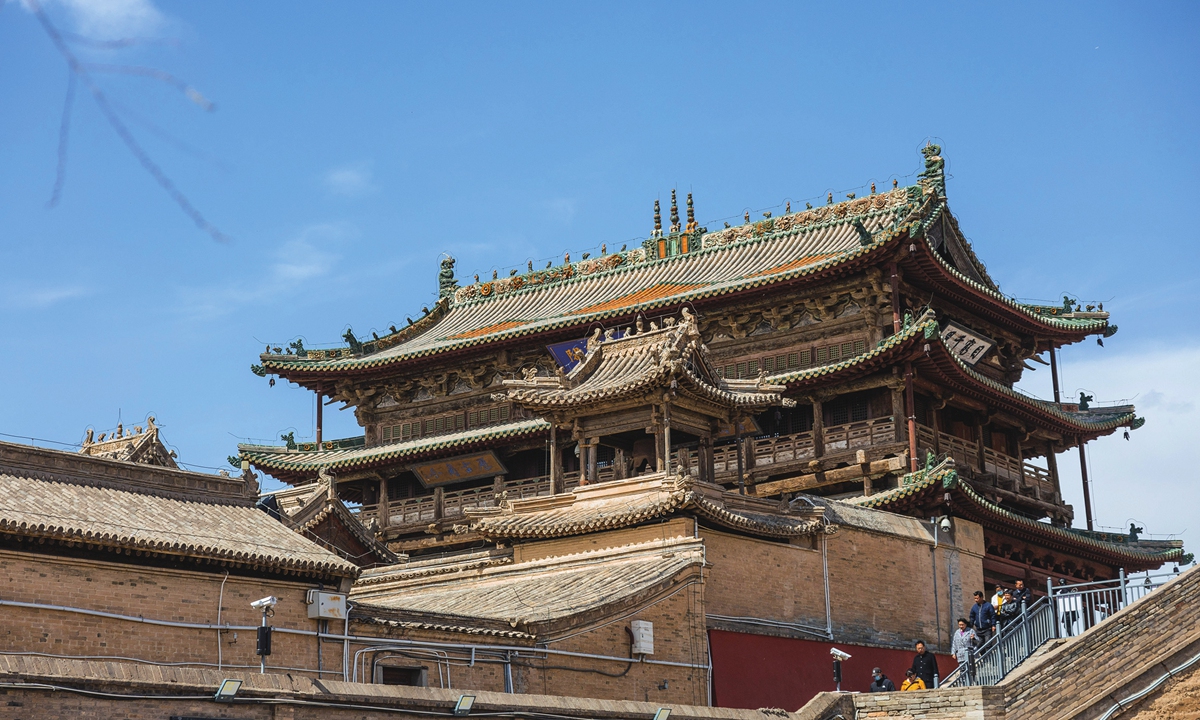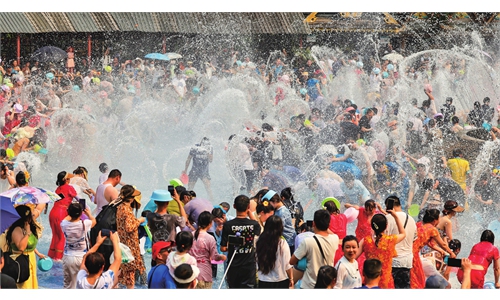ARTS / CULTURE & LEISURE
Beijing and Tianjin tourists flock to Yuxian county for heritage, hospitality
Holiday escape

The Nan'an Temple Tower Photos: Li Hao/GT
During the May Day holidays, scenic areas in Yuxian county, in Zhangjiakou, North China's Hebei Province, were packed with cars bearing Beijing and Tianjin license plates. While waiting for tables at restaurants, some tourists were also busy packing up local specialties like dried tofu, dried fruits, and yellow rice cakes.On December 30, 2024 , the 184-kilometer-long Beijing-Yuxian Expressway opened to traffic, and more and more tourists from Beijing and Tianjin are opting to travel by car to explore attractions ranging from the stunning scenery along the Zhangbei grassland to the forests of the Huichuan Scenic Area.
Meanwhile, Yuxian county, with a history spanning over 1,400 years, rich in national treasures and cultural heritage, is also gaining recognition among Beijing and Tianjin tourists for its rich cultural and historical charm.

Tourists explore the Jade Emperor Pavilion in Yuxian county, North China's Hebei Province.
Rich historyStepping into the Yuxian Ancient City scenic area, with its towering ancient city walls and clusters of ancient fortresses, feels like stepping back in time. Yet during the past May Day holidays period, various lively activities gave the ancient city a different touch.
In front of the local landmark Jade Emperor Pavilion, a model wearing a wedding dress adorned with Yuxian-style paper-cut patterns, draws crowds of tourists that want to take pictures with her. At the outdoor theater, visitors are welcomed with a festive lineup of performances, including Yangge dance shows, tai chi, waist drum dances, and bangzi performances, a genre of Chinese opera.
Located at the intersection of the Taihang Mountains, Hengshan Mountain, and Yanshan Mountains, Yuxian sits at the crossroads of several ancient cultures, including Yangshao (originating 5,000 to 7,000 years ago along the Yellow River), Hongshan (a Neolithic civilization that emerged around 6,500 years ago in North China), and Longshan (a late Neolithic civilization that developed in the middle and lower reaches of the Yellow River). This region was also a historical frontier between southern agricultural and northern nomadic civilizations.
Free to the public, the Yuxian Museum houses about 11,000 artifacts from stone sculptures, pottery, bronze ware, to calligraphy, paintings, as well as fossils of ancient vertebrates and early humans. The collection spans all historical periods and features a rich variety of categories, making the museum a cultural landmark of Yuxian county.
When the Global Times reporter visited the museum, tourists were queuing in long lines outside the entrance. While waiting, the reporter started chatting with a young couple who had also traveled from Beijing. While they frequently visited Zhangjiakou for winter skiing, they said, this was their first time visiting Yuxian county. "The museum is a must-see. For a county-level museum to possess such an extensive and rare collection is truly exceptional and awe-inspiring," said the young man.
The young couple came from Shijingshan district, west of Beijing and shared that it has become increasingly convenient driving to regions such as Yuxian county and Zhuolu county of Zhangjiakou. Given the travel convenience, they also planned to visit some other small towns in the area on their way back.
More tourists from Beijing and Tianjin are now traveling to Hebei, including younger visitors. This growing interest could spark a tourism boom in cities and towns across Hebei, further driving the upgrade of local infrastructure, improving reception capacity, and possibly raising service standards to align with those in China's most developed regions.

Bronze goose-fish lamp dating back to the Western Han Dynasty (206BC-AD220) at Yuxian Museum
A delicious traditionYuxian county is more than just its ancient artifacts and traditional dwellings.
At the Yuxian Ancient City scenic area, various small stalls offer a wide range of local snacks. One popular treat is Yuxian tianhuhu, a tangy-sweet snack made by steaming and mashing a mixture of local dried apricots and black dates, then adding hot water and letting it cool into a thick smoothie-like consistency. Another local favorite is xuanfen, a chewy and refreshing noodle dish made from mung bean or potato starch, typically served with chili oil and vinegar. In addition to the well-known Hebei specialty donkey meat huoshao (a crispy stuffed bun), donkey meat pancakes are also popular with visitors.
By midday, many tourists, tired from exploring, stop at the stalls to recharge with these tasty local bites. The reporter was drawn to a truck loaded with all kinds of hawthorn-based snacks, hawthorn jelly, hawthorn sticks, dried hawthorn slices, and more. The vendor said he would be selling here until the afternoon, as he planned to drive to Nuanquan town in the evening, where more tourists were expected to arrive.
In Nuanquan town, the reporter found that small shops along the street offer not only popular souvenirs like fridge magnets, which are quite popular across tourist spots nationwide, but also a variety of paper-cutting-themed keepsakes. It was here that the reporter learned Yuxian paper-cutting is a national-level intangible cultural heritage with a long and storied history. A vendor proudly said that they consider Nanzhangzhuang village in Yuxian as "China's Number One Paper-Cutting Village," the birthplace of Yuxian-style paper-cutting.
As it drew close to 7:30 pm, the street started to quiet down. The crowds poured into the theater to wait for the molten iron fireworks performance. Known as dashuhua (literally translated as striking tree blossoms), it is a traditional folk performance that dates back over 500 years.
Dazzling sparks soared into the night sky amid applause and cheers from the crowd, and the reporter was already looking forward to her next journey to Yuxian county.


